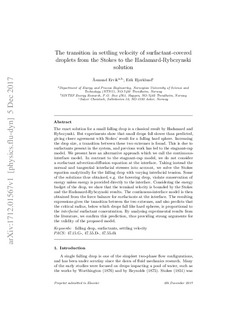| dc.contributor.author | Ervik, Åsmund | |
| dc.contributor.author | Bjørklund, Erik | |
| dc.date.accessioned | 2017-12-07T09:23:03Z | |
| dc.date.available | 2017-12-07T09:23:03Z | |
| dc.date.created | 2017-06-13T10:29:41Z | |
| dc.date.issued | 2017 | |
| dc.identifier.citation | European journal of mechanics. B, Fluids. 2017, 66 10-19. | nb_NO |
| dc.identifier.issn | 0997-7546 | |
| dc.identifier.uri | http://hdl.handle.net/11250/2469503 | |
| dc.description.abstract | The exact solution for a small falling drop is a classical result by Hadamard and Rybczynski. But experiments show that small drops fall slower than predicted, giving closer agreement with Stokes’ result for a falling hard sphere. Increasing the drop size, a transition between these two extremes is found. This is due to surfactants present in the system, and previous work has led to the stagnant-cap model. We present here an alternative approach which we call the continuous-interface model. In contrast to the stagnant-cap model, we do not consider a surfactant advection-diffusion equation at the interface. Taking instead the normal and tangential interfacial stresses into account, we solve the Stokes equation analytically for the falling drop with varying interfacial tension. Some of the solutions thus obtained, e.g. the hovering drop, violate conservation of energy unless energy is provided directly to the interface. Considering the energy budget of the drop, we show that the terminal velocity is bounded by the Stokes and the Hadamard–Rybczynski results. The continuous-interface model is then obtained from the force balance for surfactants at the interface. The resulting expressions gives the transition between the two extremes, and also predicts that the critical radius, below which drops fall like hard spheres, is proportional to the interfacial surfactant concentration. By analysing experimental results from the literature, we confirm this prediction, thus providing strong arguments for the validity of the proposed model. | nb_NO |
| dc.language.iso | eng | nb_NO |
| dc.publisher | Elsevier | nb_NO |
| dc.title | The transition in settling velocity of surfactant-covered droplets from the Stokes to the Hadamard–Rybczynski solution | nb_NO |
| dc.type | Journal article | nb_NO |
| dc.description.version | submittedVersion | nb_NO |
| dc.source.pagenumber | 10-19 | nb_NO |
| dc.source.volume | 66 | nb_NO |
| dc.source.journal | European journal of mechanics. B, Fluids | nb_NO |
| dc.identifier.doi | 10.1016/j.euromechflu.2017.05.007 | |
| dc.identifier.cristin | 1475596 | |
| dc.relation.project | Norges forskningsråd: 206976 | nb_NO |
| dc.description.localcode | This is a submitted manuscript of an article published by Elsevier Ltd in European Journal of Mechanics - B/Fluids, 10 June 2017. | nb_NO |
| cristin.unitcode | 194,64,25,0 | |
| cristin.unitname | Institutt for energi- og prosessteknikk | |
| cristin.ispublished | true | |
| cristin.fulltext | preprint | |
| cristin.qualitycode | 1 | |
